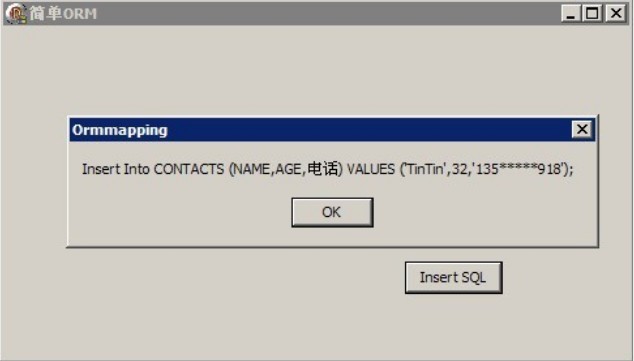[出处] http://hi.baidu.com/tintinsoft/blog/item/eaa1d1814442d0dd9023d901.html
还记得 David I 今年四月来盛大时,被问及"反射机制能再做得好一点吗?我们想放弃RTTI
", David I 回答"这的确是需要考虑的地方,当然RTTI我们不会放弃的"。(这个白胡子的老哥哥还真很可爱,当年Borland几经起落,唯一能看得顺眼的就是 David I)。 我还以为RTTI在D2010最多只是改良,炒冷饭而已。没想到,RTTI不仅能反射Public、protected、Private里的信息,还能动态执行该类里的方法,更惊奇的是,还支持Attribute。D2010 New RTTI 在某种程度上,比肩UniCode,在扩展框架上有无限的遐想空间。下面说一下 D2010 RTTI + Attribute 简单实现ORM。
1、支持ORM,最基础的两个信息是表的信息和字段信息。这两个信息,如果用Attribute 来辅助,代码更简洁和可读性更好。可以把属性名当做真实字段名,也可以将特性里的属性当成真实姓名,再加上字段标题(可以当成注释)、必填字段、是否为主键、 显示格式等等,如果没有Attribute ,类、属性的辅助信息必须用其他信息来描述,非常麻烦。
uses SysUtils, RTTI, TypInfo,Types; type Table = class (TCustomAttribute) private FName: string ; FTitle: string ; published public constructor Create(ATableName, ATitle: string ); property Name: string read FName write FName; property Title: string read FTitle write FTitle; end ; FieldInfo = class (TCustomAttribute) private FFieldName: string ; FTitle: string ; published public constructor Create(AFieldName, ATitle: string ); // 字段名 property FieldName: string read FFieldName write FFieldName; // 标题 property Title: string read FTitle write FTitle; end ;
2、有了这两个Attribute,我们必须创建一个解析属性和Attribute的类,并且能解析Insert、update、delete、 select等SQL语句。我们姑且叫 TStorable。这个类可以根据需要扩展你所想要的东西。目前只实现了Insert方法,其他的方法,留给勤奋的人去遐想。
type
TStorable = class
public
//插入SQL语句
function Insert: string;
//获取字段标题
function GetFieldTitle(const AFieldName: string): string;
//设置
//function SetAttributeValue( const PropName, AttributeValue: string ): Boolean;
end;
implementation
function TStorable.GetFieldTitle(const AFieldName: string): string;
var
Context: TRttiContext;
typ: TRttiType;
A1, A2: TCustomAttribute;
Prop: TRttiProperty;
begin
Context := TRttiContext.Create;
try
typ := Context.GetType(ClassType);
for Prop in typ.GetProperties do
begin
for A2 in Prop.GetAttributes do
begin
if (A2 is FieldInfo) and SameText(FieldInfo(A2).FieldName, AFieldName) then
begin
Result := FieldInfo(A2).Title;
Break;
end;
end;
end;
finally
Context.Free;
end;
end;
function TStorable.Insert: string;
var
Context: TRttiContext;
Prop: TRttiProperty;
typ: TRttiType;
A1, A2: TCustomAttribute;
Sqls, Fields, Values, Value: string;
begin
Context := TRttiContext.Create;
try
Sqls := '';
Fields := '';
Values := '';
typ := Context.GetType(ClassType);
for A1 in typ.GetAttributes do
begin
if A1 is Table then
begin
Sqls := ' Insert Into ' + Table(A1).Name; //获取Insert表名
for Prop in typ.GetProperties do
begin
for A2 in Prop.GetAttributes do
begin
if A2 is FieldInfo then //AHa
begin
Fields := Fields + ' , ' + FieldInfo(A2).FieldName;
//the value of the attribute
Value := Prop.GetValue(Self).ToString;
//根据数据类型对属性值加以编辑
case Prop.GetValue(Self).Kind of
tkString, tkChar, tkWChar, tkWString, tkUString:
Value := QuotedStr(Value);
tkInteger, tkInt64, tkFloat:
Value := Value;
else
Value := QuotedStr(Value);
end;
Values := Values + ' , ' + Value;
end; //for A2 in Prop.GetAttributes
end;
end; //enf of for Prop
Delete(Fields, 1, 1);
Delete(Values, 1, 1);
Sqls := Sqls + ' ( ' + Fields + ' ) VALUES ( ' + Values + ' ); ';
Result := Sqls;
end; //if A1 is Table then
end; //for A1 in typ.GetAttributes do
finally
Context.Free;
end;
end;
constructor FieldInfo.Create(AFieldName, ATitle: string);
begin
FFieldName := AFieldName;
FTitle := ATitle;
end;
3、有了上面的解析类和SQL基础,我们必须创建一个实体类。属性名是否为中文,可以有不同的说法。偶目前栖身在一个医疗行业公司,医疗专业英语术语又臭又长,奥巴马未必能拼写出几个术语。如果用属性名用中文描述,将其真实的字段名放在Attribute 里,或许更能提高程序的可读性和维护性。
unit uContact;
interface
uses SysUtils, uAttribute;
type
[Table('CONTACTS', '联系人信息')]
TContact = class(TStorable)
private
FName: string;
FAge: integer;
F电话: string;
published
public
[FieldInfo('NAME', '名称')]
property Name: string read FName write FName;
[FieldInfo('AGE', '年龄')]
property Age: integer read FAge write FAge;
[FieldInfo('电话', '联系电话')]
property 电话: string read F电话 write F电话; //尝试一下中文字段名,习惯就好
end;
implementation
end.
4、调用示例就很简单了:
procedure TForm4.btn1Click(Sender: TObject); var Contact:TContact; begin Contact : = TContact.Create; Contact.Age : = 32 ; Contact.Name : = ' TinTin ' ; Contact.电话 : = ' 135*****918 ' ; // 你还会记得918的屈辱吗? ShowMessage(Contact.Insert); ShowMessage(Contact.GetFieldTitle( ' Age ' )); Contact.Free; end;
5、综述:
ORM确实在对象映射上使用起来非常方便,但并非万能,如果过分依赖于ORM,不仅不能了解数据库表与业务的关系,而且还容易写出低效的SQL查询语句。Update语句,须谨记,字段值变化才去更改,否则,会增加数据库的数据不一致风险及其增加数据库日志开销。Delete语句,配合有关键字信息的Attribute,必要时候,还要校验是否影响单条或多条记录。
这只是一个简单的例子,离真正的生产力还差一步,为了执行SQL语句,你可以在TStorable 实现数据集的读写,然后才调用执行SQL语句。





